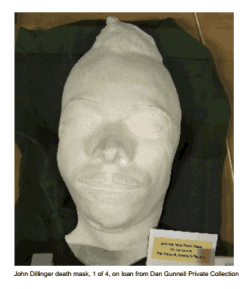|
 Illinois State Police Heritage Foundation displays John Dillinger
death mask Illinois State Police Heritage Foundation displays John Dillinger
death mask
1 of 4
originals on loan from private collection for public viewing
 Send a link to a friend
Send a link to a friend
[September 25, 2013]
SPRINGFIELD -- The Illinois
State Police Heritage Foundation Museum is extending its hours this
weekend only so that visitors can catch a rare glimpse of one of
four John Dillinger death masks in existence.
|
 Dillinger was noted by historians as the most notorious criminal in
U.S. history, standing out among more violent criminals such as Baby
Face Nelson, Pretty Boy Floyd, and Bonnie and Clyde. Dillinger
pulled off numerous robberies and murders across four states in
1933-34. Wanted by dozens of police, sheriffs and the FBI, Dillinger
met his fate at the hands of law enforcement in a hail of gunfire
outside a crowded Chicago theater. Dillinger was noted by historians as the most notorious criminal in
U.S. history, standing out among more violent criminals such as Baby
Face Nelson, Pretty Boy Floyd, and Bonnie and Clyde. Dillinger
pulled off numerous robberies and murders across four states in
1933-34. Wanted by dozens of police, sheriffs and the FBI, Dillinger
met his fate at the hands of law enforcement in a hail of gunfire
outside a crowded Chicago theater.
Four plaster death masks were cast from Dillinger's face shortly
after his death. One is on display at the National Museum of Crime &
Punishment in Washington, D.C. The Dillinger death mask at the
Illinois State Police Heritage Foundation Museum is part of the
"Gangs of Illinois" display.
"The Dillinger death mask is symbolic of the Prohibition era,
when mob bosses and bootleggers struggled to control territory
through violence with each other and with law enforcement," said Ron
Cooley, president of the Illinois State Police Heritage Foundation.
"The mask is as mysterious as it is intriguing, leaving one to guess
Dillinger's method of operation."
[to top of second column] |

The Illinois State Police Heritage Foundation Museum will be open
for this rare viewing opportunity from Thursday to Saturday, 10 a.m.
to 3 p.m., in conjunction with the Route 66 Mother Road Festival.
The museum is on Old Route 66 at 4000 N. Peoria Road in Springfield.
For more information, visit
http://isphf.org/ or call 217-525-1922.
[Text from file received from the
Illinois State Police Heritage
Foundation]
 |